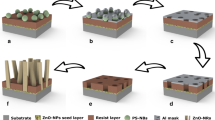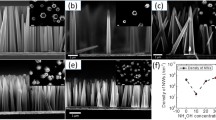Abstract
In this study, we demonstrate a method for creating multi-length-scale ZnO nanowires in a controllable manner on diverse planar and curvilinear substrates by introducing immiscible liquid masking layers (LMLs) above and beneath a nutrient solution used in hydrothermal growth. The confinement of volatile reactants by the LMLs stabilizes the pH, which is an important parameter in determining the shape of the nanowires, to enable growth in a stable manner. The conformal wettability of the LMLs provides freedom in the choice of target substrates and allows for the possibility of mounting spatially moving stages without the use of a specially designed solid lid. Selective growth within the growth zone defined by the LMLs in a dynamic- and/or static-mode can create various types of ZnO nanowires with gradual or terraced length profiles in two- or three-dimensional geometries. For a device application, we developed cylindrical photodetectors with the configuration of Cr/ZnO seed/ZnO nanowires/poly(3-hexylthiophene-2,5-diyl)/poly(3,4-ethylenedioxythiophene)-poly(styrenesulfonate) to show the ability to spatially modulate the photo-sensitivity by controlled hydrothermal growth of diverse length scales of ZnO nanowires using the LML method.






Similar content being viewed by others
References
Ng HT, Han J, Yamada T, Nguyen P, Chen YP, Meyyappan M (2004) Single crystal nanowire vertical surround-gate field-effect transistor. Nano Lett 4:1247–1252
Goldberger J, Sirbuly DJ, Law M, Yang P (2005) ZnO nanowire transistor. J Phys Chem B 109:9–14
Law M, Greene LE, Johnson JC, Saykally R, Yang P (2005) Nanowire dye-sensitized solar cells. Nat Mater 4:455–459
Jeong M-C, Oh B-Y, Ham M-H, Myoung J-M (2006) Electroluminescence from ZnO nanowires in n-ZnO film/ZnO nanowire array/p-GaN film heterojunction light-emitting diodes. Appl Phys Lett 88:202105
Wei A, Sun XW, Wang JX, Lei Y, Cai XP, Li CM, Dong ZL, Huang W (2006) Enzymatic glucose biosensor based on ZnO nanorod array grown by hydrothremal decomposition. Appl Phys Lett 89:123902
Yeh P-H, Li Z, Wang ZL (2009) Schottky-gated probe-free ZnO nanowire biosensor. Adv Mater 21:4975–4978
Kim K-H, Lee KY, Seo J-S, Kumar B, Kim S-W (2011) Paper-based piezoelectric nanogenerators with high thermal stability. Small 7:2577–2580
Wu W, Wen X, Wang ZL (2013) Taxel-addressable matrix of vertical-nanowire piezotronic transistors for active and adaptive tactile imaging. Science 340:952–957
Lee CJ, Lee TJ, Lyu SC, Zhang Y, Ruh H, Lee H (2002) Field emission from well-aligned zinc oxide nanowires grown at low temperature. Appl Phys Lett 81:3648–3650
Sun XW, Wang JX (2008) Fast switching electrochromic display using a viologen-modified ZnO nanowire array electrode. Nano Lett 8:1884–1889
Ohshima E, Ogino H, Niikura I, Maeda K, Sato M, Ito M, Fukuda T (2004) Growth of the 2-in-size bulk ZnO single crystals by the hydrothermal method. J Cryst Growth 260:166–170
Liu J, She J, Deng S, Chen J, Xu N (2008) Ultrathin seed-layer for tuning density of ZnO nanowire array and their field emission characteristics. J Phys Chem C 112:11685–11690
Conings B, Baeten L, Boyen H-G, D’Haen J, Van Bael MK, Manca JV (2012) Relation between morphology and recombination kinetics in nanostructured hybrid solar cells. J Phys Chem C 116:14237–14242
Xu C, Shin P, Cao L, Gao D (2010) Preferential growth of long ZnO nanowire array and its application in dye-sensitized solar cells. J Phys Chem C 114:125–129
Huang MH, Wu Y, Feick H, Tran N, Weber E, Yang P (2001) Catalytic growth of zinc oxide nanowires by vapor transport. Adv Mater 13:113–116
Park WI, Yi G-C, Kim M, Pennycook SJ (2002) ZnO nanoneedles grown vertically on Si substrates by non-catalytic vapor-phase epitaxy. Adv Mater 14:1841–1843
Vayssieres L (2003) Growth of arrayed nanorods and nanowires of ZnO from aqueous solutions. Adv Mater 15:464–466
Greene LE, Law M, Goldberger J, Kim F, Johnson JC, Zhang Y, Saykally RJ, Yang P (2003) Low-temperature wafer-scale production of ZnO nanowire arrays. Angew Chem Int Ed 42:3031–3034
Boercker JE, Schmidt JB, Aydil ES (2009) Transport limited growth of zinc oxide nanowires. Cryst Growth Des 9:2783–2789
Greene LE, Law M, Tan DH, Montano M, Goldberger J, Somorjai G, Yang P (2005) General route to vertical ZnO nanowire array using textured ZnO seeds. Nano Lett 5:1231–1236
Zhu R, Zhang W, Li C, Yang R (2013) Uniform zinc oxide nanowire arrays grown on nonepitaxial surface with general orientation control. Nano Lett 13:5171–5176
Bulliard X, Yun S, Ihn S-G, Choi YS, Kim Y, Choi D, Choi J-Y, Choi W (2010) Density control of ZnO nanorod arrays on mixed self-assembled monolayers. Cryst Growth Des 10:4697–4700
Kim KS, Jeong H, Jeong MS, Jung GY (2010) Polymer-templated hydrothermal growth of vertically aligned single-crystal ZnO nanorods and morphological transformations using structural polarity. Adv Funct Mater 20:3055–3063
Tian ZR, Voigt JA, Liu J, Mckenzie B, Mcdermott MJ (2002) Biomimetic arrays of oriented helical ZnO nanorods and columns. J Am Chem Soc 124:12954–12955
Joo J, Chow BY, Prakash M, Boyden ES, Jacobson JM (2011) Face-selective electrostatic control of hydrothermal zinc oxide nanowire synthesis. Nat Mater 10:596–601
Hu X, Masuda Y, Ohji T, Kato K (2008) Micropatterning of ZnO nanoarrays by forced hydrolysis of anhydrous zinc acetate. Langmuir 24:7614–7617
Kwon SJ, Park J-H, Park J-G (2005) Patterned growth of ZnO nanorods by micromolding of sol-gel-derived seed layer. Appl Phys Lett 87:133112
Hsu JWP, Tian ZR, Simmons NC, Matzke CM, Voigt JA, Liu J (2005) Direct spatial organization of zinc oxide nanorods. Nano Lett 5:83–86
Wang CH, Wong ASW, Ho GW (2007) Facile solution route to vertically aligned, selective growth of ZnO nanostructure arrays. Langmuir 23:11960–11963
Ko SH, Lee D, Hotz N, Yeo J, Hong S, Nam KH, Grigoropoulos CP (2012) Digital selective growth of ZnO nanowire arrays from inkjet-printed nanoparticle seeds on a flexible substrate. Langmuir 28:4787–4792
Chen CC, Lin YS, Sang CH, Sheu J-T (2011) Localized joule heating as a mask-free technique for the local synthesis of ZnO nanowires on silicon nanodevices. Nano Lett 11:4736–4741
Yeo J, Hong S, Wanit M, Kang HW, Lee D, Grigoropoulos CP, Sung HJ, Ko SH (2013) Rapid, one-Step, digital selective growth of ZnO nanowires on 3D structures using laser induced hydrothermal growth. Adv Funct Mater 23:3316–3323
Morin SA, Amos FF, Jin S (2007) Biomimetic assembly of zinc oxide nanorods onto flexible polymers. J Am Chem Soc 129:13776–13777
Manekkathodi A, Lu M-Y, Wang CW, Chen L-J (2010) Direct growth of aligned zinc oxide nanorods on paper substrates for low-cost flexible electronics. Adv Mater 22:4059–4063
Qin Y, Wang X, Wang ZL (2008) Microfibre-nanowire hybrid structure for energy scavenging. Nature 451:809–813
Xiao X, Yuan L, Zhong J, Ding T, Liu Y, Cai Z, Rong Y, Han H, Zhou J, Wang ZL (2011) High-strain sensors based on ZnO nanowire/polystyrene hybridized flexible film. Adv Mater 23:5440–5444
Liu Y, Das A, Xu S, Lin Z, Xu C, Wang ZL, Rohatgi A, Wong CP (2012) Hybridizing ZnO nanowires with micropyramid silicon wafers as superhydrophobic high-efficiency solar cells. Adv Energy Mater 2:47–51
Wang L, Tsan D, Stoeber B, Walus K (2012) Substrate-free fabrication of self-supporting ZnO nanowire arrays. Adv Mater 24:3999–4004
Wen X, Wu W, Ding Y, Wang ZL (2012) Seedless synthesis of patterned ZnO nanowire arrays on metal thin films (Au, Ag, Cu, Sn) and their application for flexible electromechanical sensing. J Mater Chem 22:9469–9476
Shaw DG, Maczynski A, Goral M, Wisniewska-Goclowska B, Skrzecz A, Owczarek I et al (2006) IUPAC-NIST solubility data series. 81. hydrocarbons with water and seawater-revised and updated. Part 11. C13–C36 hydrocarbons with water. J Phys Chem Ref Data 35:687–784
Miller DJ, Hawthorne SB (2000) Solubility of liquid organics of environmental interest in subcritical (hot/liquid) water from 298 K to 473 K. J Chem Eng Data 45:78–81
Park SY, Kim BJ, Kim K, Kang MS, Lim K-H, Lee TI, Myoung JM, Baik HK, Cho JH, Kim YS (2012) Low-temperature, solution-processed and alkali metal doped ZnO for high-performance thin-film transistors. Adv Mater 24:834–838
Walter A, Gutknecht J (1986) Permeability of small nonelectrolytes through lipid bilayer membranes. J Membrane Biol 90:207–217
Xu S, Wang ZL (2011) One-dimensional ZnO nanostructures: solution growth and functional properties. Nano Res 4:1013–1098
Richardson JJ, Lange FF (2009) Controlling low temperature aqueous synthesis of ZnO. 1. thermodynamic analysis. Cryst Growth Des 9:2570–2575
Ashfold MNR, Doherty RP, Ndifor-Angwafor NG, Riley DJ, Sun Y (2007) The kinetics of the hydrothermal growth of ZnO nanostructures. Thin Solid Films 515:8679–8683
Santos FJV, Castro CAN, Dymond JH, Dalaouti NK, Assael MJ, Nagashima A (2005) Standard reference data for the viscosity of toluene. J Phys Chem Ref Data 35:1–8
McLinden MO, Splett JD (2008) A liquid density standard over wide ranges of temperature and pressure based on toluene. J Res Natl Inst Stand Technol 113:29–67
Peiró AM, Ravirajan P, Govender K, Boyle DS, O’Brien P, Baradley DDC, Nelson J, Durrant JR (2006) Hybrid polymer/metal oxide solar cells based on ZnO columnar structures. J Mater Chem 16:2088–2096
Baeten L, Conings B, Boyen H-G, D’Haen J, Hardy A, D’Olieslaeger M, Manca JV, Van Bael MK (2011) Toward efficient hybrid solar cells based on fully polymer infiltrated ZnO nanorod arrays. Adv Mater 23:2802–2805
Gonzalez-Valls I, Lira-Canti M (2009) Vertically-aligned nanostructures of ZnO for excitonic solar cells: a review. Energy Environ Sci 2:19–34
Takanezawa K, Tajima K, Hashimoto K (2008) Charge separation interfaces in polymer photovoltaic devices hybridized with ZnO nanorod arrays. Jpn J Appl Phys 47:8049–8053
Acknowledgements
This research was supported by Basic Science Research Program through the National Research Foundation of Korea (NRF) funded by the Ministry of Education, Science and Technology (2013011022).
Author information
Authors and Affiliations
Corresponding author
Electronic supplementary material
Below is the link to the electronic supplementary material.
Rights and permissions
About this article
Cite this article
Jang, H.S., Son, B., Song, H. et al. Controlled hydrothermal growth of multi-length-scale ZnO nanowires using liquid masking layers. J Mater Sci 49, 8000–8009 (2014). https://doi.org/10.1007/s10853-014-8507-6
Received:
Accepted:
Published:
Issue Date:
DOI: https://doi.org/10.1007/s10853-014-8507-6




